With our 26-foot motorhome and trailer we headed north along Highway 97 from Quesnel to begin our week-long adventure to the Queen Charlotte Islands. The four of us (Tom, Beryl, Delle and Phil) were loaded for what ever may befall us, and certainly a lack of food would not be an issue. How is it that women can figure out how to get a week’s worth of food in a RV fridge is beside me. I guess it must be similar to getting all the tools to fit into a toolbox for us guys.
A few miles up the highway, we had an issue with the quad trailer that could have ended in tragedy. Someone in their haste to hook up didn’t secure the hitch properly and things began to go wrong after a series of bumps in the road. Upon inspection we found some serious road rash on the bottom of the trailer hitch, but it was nothing a quick stop in Prince George couldn’t fix. A few hours later, and a few “thank goodness for safety chains” we pulled into the Houston airport for the night.
Bright and early the next morning after breakfast and a check of the trailer hitch we were on Highway 16, heading west to the Pacfic Ocean and the smell of the sea. We arrived in Prince Rupert, found a campsite, and supper was quickly cooking. We all walked to the docks for a check of the ferry schedule, everything was in order for the next morning. The guys walked down among the fishing boats while the girls wandered back to the motorhome as a slight mist began to fall. What would Prince Rupert be without rain, right? Of course during the night the light mist turned to a heavier rainstorm, and with that came a small drip, drip, drip in the ceiling of the motorhome. Nothing a bucket couldn’t handle.
Everyone was up early and excited about the ferry ride and visiting the islands. We loaded on the ferry about 10:30 a.m. and set sail at 11:30. The rain finally stopped, but a slight breeze kept the ferry’s flag full out front as we sailed between the smaller islands and into Hecate Strait.
We arrived at Skidegate on the north island about 5 p.m. and found a campsite at Misty Meadows Campsite next to the Telell River. Our maps told us we wanted to explore around this area the next morning, so we spoke with the camp host about where we could unload our quads. Fiddlin' Freddie Bernard was full of tips about what we were going to see, but he also warned us about how important the tides were. Not being from an area where tides are important, we listened carefully and studied the tide chart around the campfire that night.
Early next morning after a hearty breakfast we drove to the river and unloaded the quads. The tide chart said the river would be lowest around 9:15 a.m. and we were there, ready to forge across the Telell River. Across the river we went and onto the sandy beach toward the shipwreck Pesuta. The large, upended wreck beckoned the cameras to take a shot or two. Poking around in the sand we found numerous lengths of the ship's chain, rusting away and turning the sand around it brown.
We headed north up the sandy beach, leaving nothing behind but our quad tracks, soon to be erased by the incoming tide. We stopped a few times and picked shells and checked out some trails that wove their way down to the beach. We could see a storm front moving in, so we headed back to the wreck and the river. Water was a little higher this time, about 24 inches, so you really had to lift up your feet or they would be wet for the rest of the day.
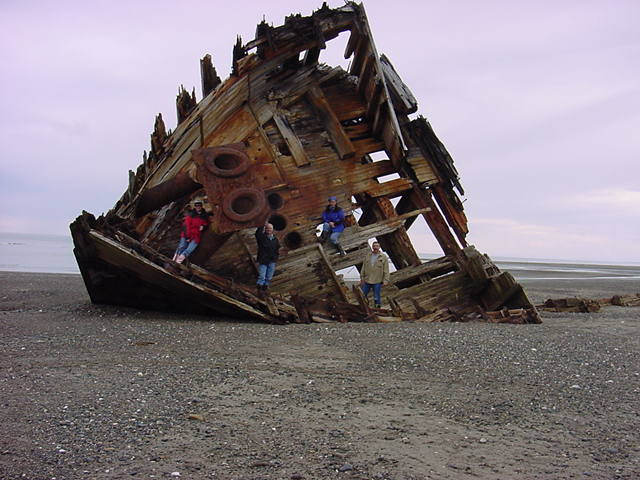
Inspecting a shipwreck is all part of the adventure near the Telell River on the Queen Charlotte Islands. — Photo courtesy Phil Megyesi
After loading the quads we headed up the highway to Masset at the northern end or top of the island. Our maps said we could then turn east and drive to Tow Hill, a place where the sea blows up through holes in the rocks. We found a newly constructed campsite, built by the Haida, and not a soul around. We parked right on the beach and went for a walk in the late afternoon sun. What a glorious scene.
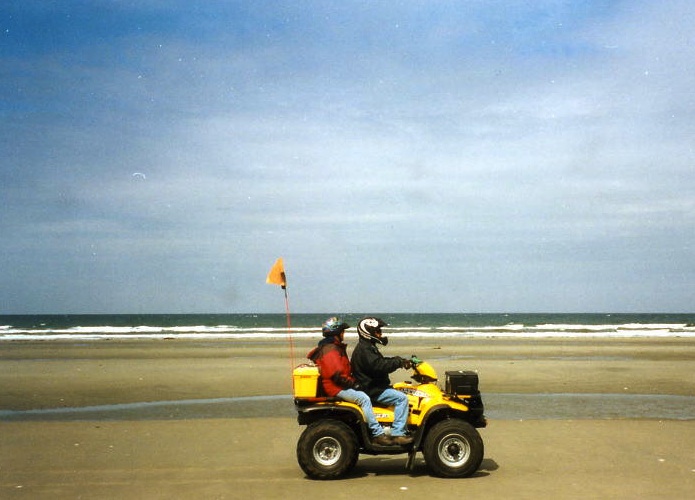
Riding across the beach. — Photo courtesy Phil Megyesi
After supper we unloaded the quads and went for a ride to Rose Spit. Likely the best part of our trip was this evening ride. It is about 15 kilometres along this beach, with lots of small boat wrecks, washed up crab pots, miscellaneous debris and lots of plastic water bottles. I guess they never sink. As we approached the furthest point of land of the islands we found a strange phenomenon. A strong breeze had been with us throughout our evening ride, but as we got off our quads and walked to the eastern side of the island the air was perfectly calm, not a breath of wind. When we looked back to where we had got off our machines, the wind was buffeting the flags mounted on the quads. As we looked to the northeast we could just make out the islands and mountains that make up the Alaska panhandle. The sun was setting as rode back to camp, and the waves were crashing onto the beach as we rode into the wind. We gathered up some driftwood and built a fire on the beach and watched the sunlight drift away as the darkness overtook it.
The next day we rode west to Agate Beach. There are lots of things on the beach to check out: sea shells, washed-up debris tangled with fishing lures, more crab pots and even a fire pit that was begging for a weiner roast—so we complied. After lunch, we headed back to the motorhome and loaded up the quads and found a campsite with showers. Apparently some of us had begun to smell. I thought it was the ocean, but I guess not. After a tremendous dinner complete with a few glasses of fine wine, we enjoyed another evening fire.
The next day was a typical tourist day. We went into Masset and then further west to Old Masset for pictures with Haida totem poles. We found a museum and poked around in there. Adjacent to that was a store with Haida artifacts for sale. We wandered around Masset for a few hours, went down to the docks, even visited a fish cannery, but unfortunately there were no tours that day.
Later in the day we headed for Queen Charlotte City. Along the way we stopped for a visit to the balance rock that is so famous and met an Aboriginal person in the area who tried as a youngster to pull it down with his pickup truck. Fortunately he failed. We did some grocery shopping (had to keep that fridge full, you know) in Queen Charlotte City and then headed for Rennel Sound. We found a secluded spot on the top of the hill, basically a wide spot in the road, and made camp.
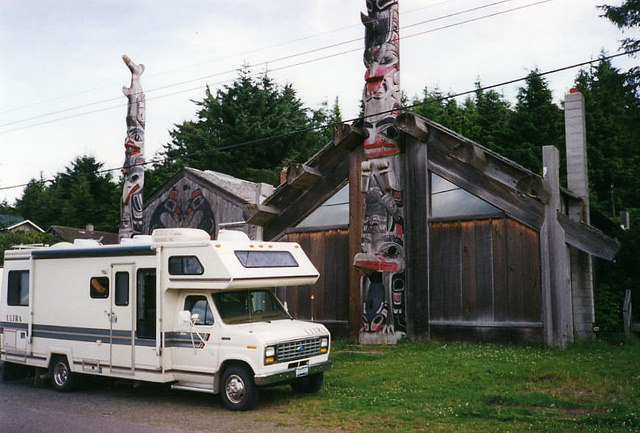
Megyesi and his friends stop at Old Masset to take in the tourist sites, including Haida totem poles. — Photo courtesy Phil Megyesi
The hill was far to steep too go down with our motorhome. (If any of you have been to this hill, you may know why we choose not to go down it with our unit. Tales of this hill are famous throughout the island.) We unloaded the quads and went down the next morning. At the bottom of the steep hill you either have to go right or left, and if you don’t you will get very, very, wet, because the ocean is right in front of you. The contractor who built this road certainly wasn’t thinking of tourists and RV traffic, because it is extremely steep and difficult to traverse. Once you are down there, though, the sights are worth it. Lots of open ocean, lots of pounding surf, and debris washing up on the beach all the way from Japan. We toured around the inlets for the rest of the day, finding all manner of things, including a fishing gaff and more abandoned crab pots. There must be a abundance of these on the islands, as everyone seems to be losing them and doesn’t seem to bother picking them up. We headed back up the hill as the rain began to fall, had supper and stayed indoors that evening as the weather was not pleasant. And besides, we had our evening’s entertainment: dodging the drip in the motorhome.
Next day, we rode the quads inland to the Yakoun River. We tried fishing, but had no luck. We found a logging road and went to the top of a mountain and found a logging crew that were doing routine maintenance on a high lead operating equipment. They were logging huge cedar trees, getting them ready to ship to the ocean, likely going to China or Japan.
Our last day on the islands began with a cloudy outlook on things. We left the top of the hill and headed for the east side of the island. The sun came out as we unloaded the quads and headed up-river from the Pesuta. We packed a picnic lunch so we were prepared for a great afternoon. After travelling about 20 kilometres on the beach we encountered some high cliffs that had been weathered over time. Eagles were drifting around in the high altitude heat. We had a light lunch and headed back to the motorhome. Our ferry was scheduled to leave about 9 p.m. that night, so we had plenty of time to enjoy our first restaurant meal of the trip. Seafood was on the menu and we certainly took advantage of that.
We boarded the ferry at 10:30 that evening and arrived in Prince Rupert at 7 a.m. the following morning. Following an hour of driving, we took a rest along the Skeena River and cooked up the last of the bacon and eggs before we headed out on the long drive back to Quesnel.
During our drive home we discussed the week we had just spent on the islands. We all felt it had been a good week. Prices of fuel and food were not as expensive as we had been led to believe by others before we left Quesnel. Perhaps the people of the islands are more laid-back than in the big city, but that is their lifestyle and they are certainly entitled to live the way they want. We thoroughly enjoyed our time spent there and would go back if the opportunity presented itself. We felt the only downside was the ferry trip and cost to get there. But it was a holiday, and you should never put a cost restraint on that type of entertainment. Just enjoy it as a once in a lifetime experience, as we did.
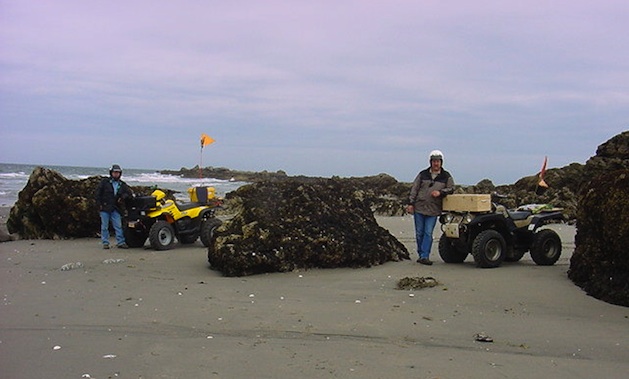



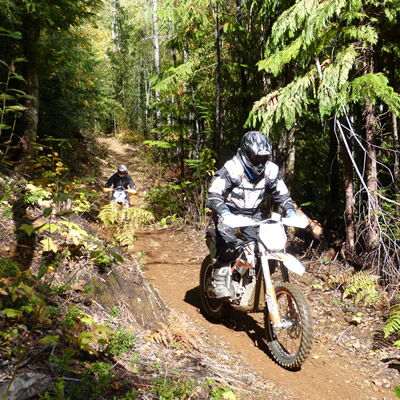


Comments